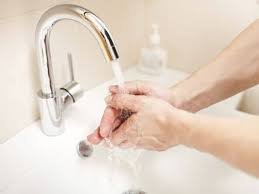Hand washing is one of the easiest and inexpensive measures to prevent the spread of the disease. Our own hands are often the intermediary of various bacteria to enter into our bodies. In order to achieve maximum results, you should know how to properly hand wash techniques.

Why Hand Washing?
A flu sufferer covers his nose with his hands while sneezing, then grips the handle on the bus, when you hold the handle, the flu bacteria can immediately move into your hands and if you hold your nose or mouth, the germ can enter into our body. That's how easily germs move from one person to another. Diseases such as diarrhea, intestinal worms, Acute Respiratory Infections (ARI), tuberculosis and even deadly diseases such as SARS, avian influenza (H5N1) and swine flu (H1N1) can be prevented by hand washing properly. Unfortunately, many people who perceive these healthy habits and consider them unimportant. Yet by getting used to wash hands properly, your life and family can be healthier.

How to Wash the Right Hand
Proper hand washing should use soap and under running water. While the correct handwashing techniques steps are as follows.
• Wet hands with water under a tap or running water.
• Take enough liquid soap for the whole hand. It would be better if the soap contain an antiseptic.
• Rub your palms together.
• Rub to the fingertips.
• The palm of the hand rubs the back of the left hand (or vice versa) with the fingers interlocking (intermittent) between the right and left hands. Rub between the fingers. Do the opposite.
• Place the back of one finger with the back of the other finger and lock each other.
• Rub your right thumb with your left palm in a circular motion. Do the same with your left thumb.
• Rub the palm of the hand with the back of the other finger with the movement forward, back and spin. Do the opposite.
• Hold your right wrist with your left hand and do a circular motion. Do it for the left hand.
• Clean the soap from both hands with running water.
• Dry your hands with a tissue and when using a faucet, cover the faucet with a tissue.
Drying with tissue is better than drying your hands using a common hand dryer in the mall. Because hand dryers are generally used to accommodate many bacteria that can transmit to others.
When When You Wash Your Hands?
Hand washing is generally done before the meal, before preparing the food, after handling raw meat, before and after touching the sick, after using the bathroom, after coughing or sneezing or blowing the nose, after changing diapers or pads, before and after treating wounds, after cleaning or disposing of garbage, after touching animal or animal dung.
You should also teach the good habit of washing your hands to your young child. A child loves to learn and touch everything without knowing whether it is dirty or not. Then put his hand into his mouth or eat food without washing his hands. As a result the child can suffer from illness. According to research, the number one killer of children in Indonesia is due to diarrhea, but this can be prevented by teaching children to wash hands.
Given the importance of handwashing, every October 15th ladder was declared a World Handwashing Day. Familiarize yourself and your family to wash hands right now.
reference:
http://fourseasonnews.blogspot.com/2012/06/pengertian-mencuci-tangan.html
http://adelinecalonperawat.blogspot.com/2009/03/sap-penyuluhan-cuci-tangan.html
http://www.infeksi.com.Pusat Informasi Penyakit Infeksi, Andy Baex, 6 Februari 2007
done follow bro...